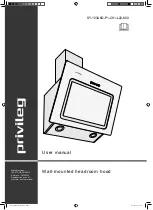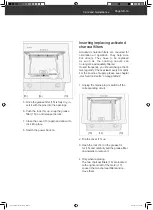
For your safety
Page GB-6
■
Cleaning and maintenance must not
be carried out by children unless they
are supervised.
■
Children must not be allowed to play
with the appliance.
Risks in handling exhaust hoods
WARNING
Risk of electric shock!
■
Before drilling the holes to mount the
appliance on the wall, ensure that
no wires or cables (power, gas, water
etc.) will be damaged (check with a
line locator).
■
If a glass cover is broken, the exhaust
hood must not be used until the glass
cover has been replaced. If this is the
case, contact our customer service
(see page GB-22).
CAUTION
Risk of injury!
■
When mounting, please note that
some parts may have sharp edges.
■
Use a stable stepladder to mount.
■
Only use mounting materials that are
suitable for the characteristics of the
ceiling and walls. When in doubt, con-
sult an expert.
Fire hazard!
■
The distance between the cooking
surfaces and the lower edge of the
hood must be at least 65 cm for gas
stoves.
■
For gas stovetops, you must read the
user manual for the stovetop! If the
manual stipulates a larger distance,
this must be observed.
■
Do not fl ambé foods under the ex-
haust hood!
■
Only deep-fry foods under the ex-
haust hood under constant supervi-
sion.
■
Keep the exhaust hood clean. Grease
build-ups can ignite when heated to
high temperatures.
■
Clean the exhaust hood according to
the instructions.
Risk of burns!
■
Touchable parts may become hot if
used with cooking appliances.
Risks during exhaust air operation
WARNING
Risk of suffocation/explosion!
The air in the room where the exhaust
hood is operating is extracted by fan
and released outside. If, in this room, a
fi replace requiring indoor air – such as a
gas fi re or other fuel-based heating sys-
tem – is also in use, the oxygen that is
necessary for combustion may also be
extracted. This can result in the fl ame
being extinguished and gas being re-
leased or the room becoming saturated
with exhaust fumes.
■
It is possible to run the appliance
without any risk by, for example,
providing non-sealable openings in
doors, windows or ventilation con-
duits through which the combustion
air can escape, and by achieving a
negative pressure level in the instal-
lation space of maximum 0.04 mbar.
This prevents the exhaust fumes from
being sucked back into the room.
196374_GB_20180516.indd GB-6
196374_GB_20180516.indd GB-6
17.05.2018 14:13:06
17.05.2018 14:13:06
















































